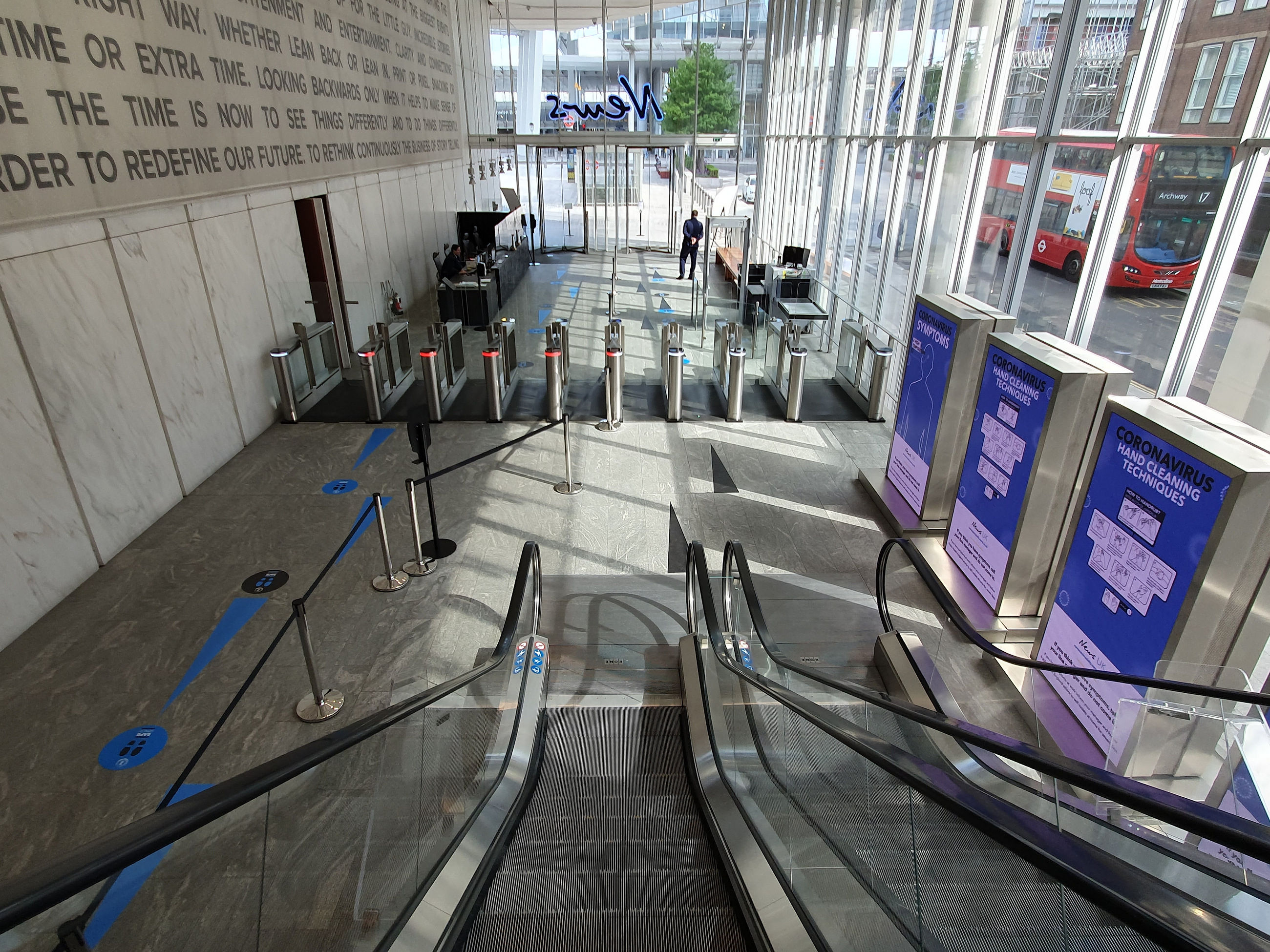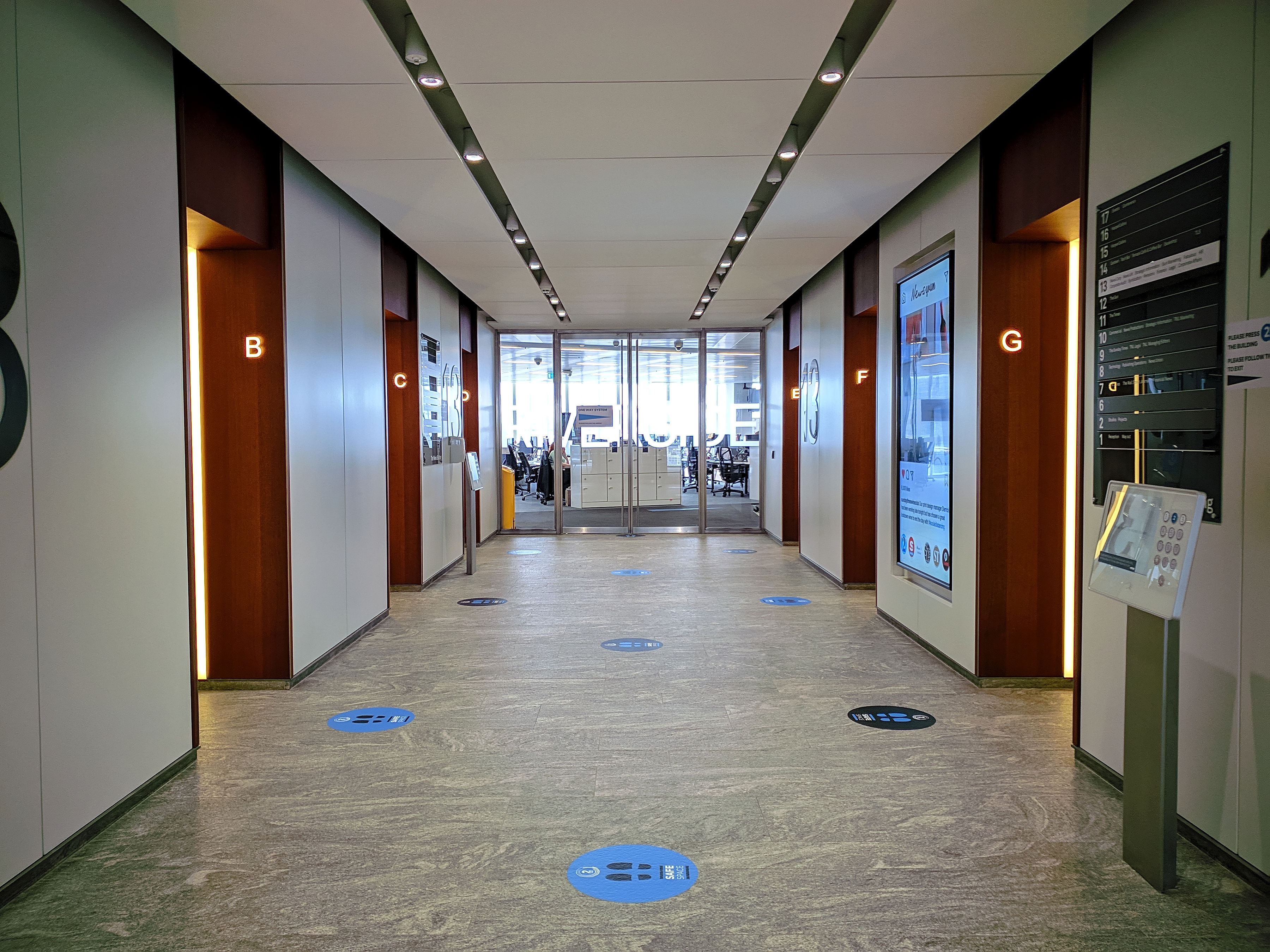‘Safe-space’ signs and which direction to face: At 30% capacity, how News UK is returning to the office

Organizations are keen to tout how productive their remote-working realities are. But since government-mandated stay-at-home orders were put in place in March, companies have been thinking about how to return to the office, albeit cautiously.
The News Building, a 17-storey office block in London Bridge, houses Rupert Murdoch’s U.K. media businesses including The Times, The Sun, The Wall Street Journal, Dow Jones and Virgin Radio. Before the coronavirus, it also housed 3,400 staff. But since the beginning of July, the office has been operating at a maximum capacity of 30%.
As staffers begin to trickle back in they’ll see “an alien-looking newsroom,” said editor of The Sunday Times Emma Tucker, speaking back in June when restrictions for returning to work were tighter. Tucker has been coming into the “eerily silent office” since March on Thursday, Friday and Saturday. “There are only six chairs around the conference table and you can’t move for all the hand sanitizer.”
In the next 12 to 18 months, 82% of people will be back in the workplace for good, according to research from Xerox, which surveyed companies in U.S., Canada, the U.K., Germany and France. And while organizations are quick to say that employee safety is paramount, it’s not that straightforward. As of June, 65% of U.K. workers said they felt uncomfortable about returning to the office, while 20% were expected to do so that month, according to research by management software firm Qualtrics.
“The return to the office is political and fraught,” said Mira Kopolovic, senior social scientist at behavioral agency Canvas8. “People might not feel comfortable saying that they don’t want to return in case it’s perceived as a lack of commitment to the company.”
Throughout the crisis, News UK set up an Emergency Response team to draft clear plans and guidelines. The office has remained open throughout the pandemic for News UK’s essential workers, journalists and radio broadcasters if they choose to come in. Since July, masks must be worn on entering and leaving — staffers are given a pack of three on their first day back — and a traffic light system for cleaning each desk cleaning is in place, (open, closed and to be cleaned) as well as a one-way foot-traffic system.
With 17-stories, elevators are pretty much a necessity. Now, with a maximum of three per elevator, “safe space” signs show people which direction to face and are manned by a team who press the buttons for staff.

“There have been weeks where four or five people have come in to put together the paper,” said Tucker, listing off a couple of commissioning editors, designers, a production editor and picture editor. “Which is an amazing fact, you certainly couldn’t have done that 15 years ago.”
Tucker has had days where only herself and a messenger have been on the ninth floor, where The Sunday Times is stationed. Conference meetings that typically would have had staff across the whole paper, including editorial, marketing and commercial, filling the chairs and huddling around the edge, are replaced with a handful of people sat two meters apart, the rest joining via video conference. While the newspaper gets printed, it’s far from ideal, said Tucker.
“It’s been ok. If you had a choice, you’d rather everyone was here,” she said.
Food items for lunch and dinner are available from points on each floor at specified times and communal areas are cleaned every 15 minutes. It has now also opened one of its cafes for takeaways. Staffers drop off their bags and coats at designated areas on each floor to avoid too many items on desks. One in four desks is currently being used in the newsroom and follow a team rota system.

Although most meeting rooms are still closed, and without being able to hold face-to-face meetings, some staffers question the reason for going in when they can simply Zoom from their homes, according to sources.
Over half (51%) said what they missed most about the office was being able to see colleagues and collaborate face-to-face, according to a study carried out by Quartz. While 24% said they’re happy to not be back in the workplace.
That reality is making publishers rethink their commercial real estate — often the second-highest cost after staff — to hopefully avoid cuts. Condé Nast for one is trying to break the lease of its 21 floors at One World Trade Center, which is meant to last until 2039, for cheaper rent in Midtown since discovering 70% of its workforce expressed interest in some form of flexible or full-time remote work arrangement. Tribune Publishing is giving up its newsroom space in New York, Allentown, Annapolis, and Orlando. Smaller publishers have been able to break shorter leases.
For some, a fresh space elsewhere sounds pretty good. “I never liked our office really, there were rat traps in there,” said one executive at a mid-sized publisher, whose lease, luckily, is up.
This article has been updated to say that Emma Tucker was speaking in June. Since then News UK has opened one of its cafes for takeaway service and desk use follows a rota system.
More in Media

Media Briefing: The top trends in the media industry for 2025
This week’s Media Briefing takes a look at the top trends from 2025, from digital advertising revenue performance to AI licensing deals.

Digiday Scorecard: Publishers rate Big Tech’s AI licensing deals
Digiday has compiled a scorecard grading AI platforms to make sense of the growing number of players in the AI content licensing market.

Publishers are hunting for AI prompt data — now they’re starting to get it from third-party companies
Publishers are finally gaining some visibility into AI search, as new prompt data tools crack open a black box.







